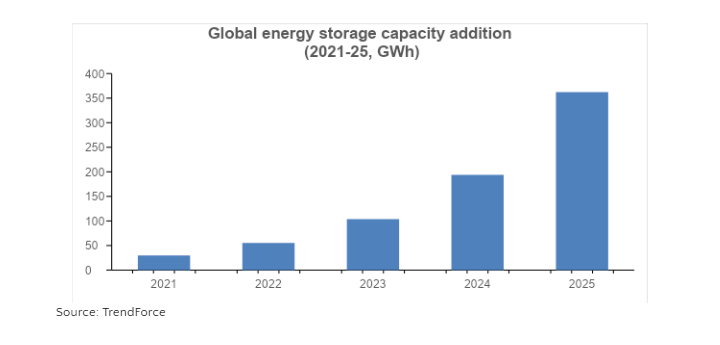The global power sector is going through transformational changes. Electricity generation through renewable energy sources has accelerated rapidly in the last decade and is expected to rise further on growing environmental concerns over the use of power derived from fossil fuels, favorable renewable-energy-focused government policies, and the falling cost of renewable energy production. Solar and wind, both renewable energy sources, accounted for the majority of new global electricity generation capacity additions in 2021. However, the pace of transition to renewables and low-carbon power generation is not adequate to meet the carbon neutrality goal by 2050. Therefore, it is imperative that a portfolio of clean technologies and solutions is evaluated and adopted to reduce the carbon footprint of the power sector.
Battery storage is one solution that supports the power sector’s transition to carbon neutrality. Battery Energy Storage Systems (BESS) allows the storage of electricity at times of excess generation and low electricity demand, and utilization of the excess electricity at a time when generation is lower than electricity demand. Key components of an energy storage system include batteries, which store electricity; power conversion system, which enables AC/DC and DC/AC conversion, and battery management system, which manages battery charging, as well as balances and monitors overall system health. Several new technologies and solutions are under development for each component of the BESS in order to accelerate the adoption of energy storage systems.
BESS’s biggest strength lies in its ability to overcome the operational challenges tied to distributed and renewable energy sources. BESS hastens the transition from carbon-heavy power generation. Integrated with renewable energy sources, BESS allows the storage of renewable electricity, the majority of which is generated during non-peak hours (afternoon), for use at peak hours, offsetting the dependence on fossil-fuel-focused power plants. In addition, it offers improved and reliable power quality, as the batteries allow better management of load, generation, and frequency. BESS also improves power quality, is available in remote locations, which receive intermittent electricity supply, and may be better managed through a microgrid model.

With a focus on increasing renewable energy capacity and grid stability, the global energy storage market has been rapidly growing. In 2021, the industry recorded ~72% year-on-year growth, with ~30 GWh of capacity additions. The industry is expected to add 362 GWh by 2025. China – the fastest-growing market – is expected to overtake Europe and the US as the largest market. China’s energy storage capacity is on track to reaching 100 GWh by 2025. The US and Europe are also expected to record strong growth rates, with installed capacity expected to reach 136 GWh and 56 GWh, respectively, by 2025.
The battery storage market is dominated by lithium-ion batteries, largely used in electric cars and large-scale power projects. However, the sector is expected to be driven by a rapidly evolving technological landscape. Lithium-ion batteries are expected to dominate the market, and several new lithium-ion battery chemistries are being adopted. Lithium-iron phosphate (LFP) batteries dominated the battery storage capacity addition in 2021 for the first time, surpassing nickel-manganese-cobalt (NMC) batteries. LFP-battery advantages include lower cost, greater safety and higher durability than NMC batteries. LFP is expected to become the lithium-ion battery chemistry of choice till 2030, driven by growing adoption in China and the rest of the world. Flow battery is another promising storage technology, with a longer life cycle and greater energy capacity. However, it has lower energy density and is not yet commercially viable. Sodium-ion batteries, a competing battery technology to lithium-ion chemistries, are also expected to witness a growth in market share by 2030.
Battery storage is likely to be an essential technology to accelerate the transition from fossil fuels and the adoption of renewable energy. Battery storage systems hold the potential to plug the gap between the transition to clean energies and meet changing electricity needs. However, the technology needs to overcome several challenges before it can be implemented at the rate required to achieve the Paris Climate Agreement’s ambition of curbing global temperature increase to 2° C. Vague and outdated definition of energy storage is the biggest challenge for the battery storage industry. In several countries, battery storage is considered a generation asset, and transmission as well as distribution companies are not allowed to own battery storage assets. This creates a barrier in the value chain of transmission and distribution companies, which are an important potential investor category for the industry. Other industry challenges include the lack of standardization, unfavorable regulatory policies, and unclear energy storage economics.














